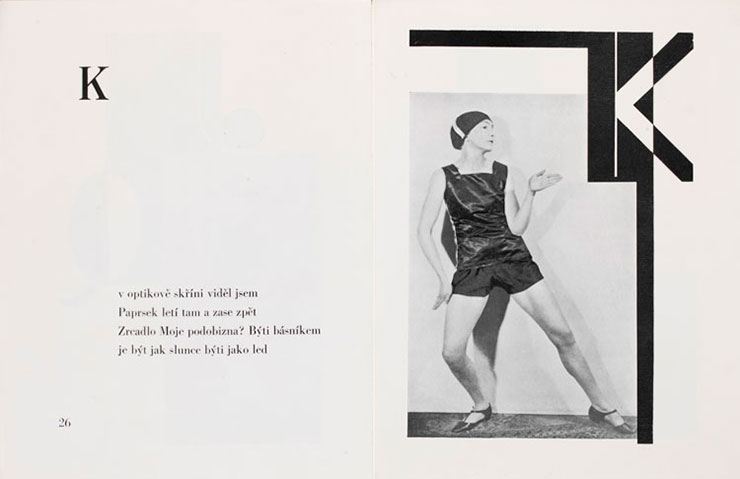Dance for type: Karel Teige’s avant-garde choreographed alphabet
“Abecada” aka “The Alphabet” is a composite of experimental poetry, modern dance, graphic design and photomontaged typography, based on a poem by Vitĕzslav Nezval in the order of the letters of the Latin alphabet and created by art theorist and critic, graphic designer, typographer, artist, author and translator Karel Teige. internationally acclaimed surrealist and a leading figure of the European avant-garde.
Choreographed by Milča Majerová into a brilliant photo-ballet in twenty-four hypnotic poses, the alphabet is shaped by the body movement and vice versa with each move in the dance made to the visual counterpoint of Karel Teige’s astonishing typographic music “as angular as jazz, as syncopated as Stravinsky!”.
“In Nezval’s Abeceda, a cycle of rhymes based on the shapes of letters, I tried to create a 'typofoto' of a purely abstract and poetic nature, setting into graphic poetry what Nezval set into verbal poetry in his verse, both being poems evoking the magic signs of the alphabet” said Teige of the 1926 book Alphabet (Abeceda), a landmark achievement in European modernism.
“The book consists of a series of rhymed quatrains by Devetsil poet Vitezslav Nezval, titled and ordered according to the letters of the Latin alphabet. Facing each set of verses is a Constructivist photomontage layout by Karel Teige, a painter turned typographer who was also Devetsil's spokesperson and leading theorist” writes Matthew S. Witkovsky.
“Teige developed his graphic design around photographs of dancer and choreographer Milada (Milca) Mayerova, a recent affiliate of the group, who had performed a stage version of 'Alphabet' to accompany a recitation of the poem at a theatrical evening in Nezval's honor in April 1926... The project to create a new alphabet epitomizes the proselytizing attitude of avant-gardists in various fields in the years after World War I.
From Dada poetry to Constructivist architecture and design, from calls to overhaul theater to revolutions in literary theory, a panoply of experiments took the alphabet as their model or target and disclosed the potency of this elementary linguistic structure as a trope for creative renewal and social revolution. With its large print, childlike verses, and an instructional sequence that matches a single letter in text and image on every page spread, Alphabet presents itself as the class reader for that internationally sponsored course in universal reeducation.”
Karel Teige (1900-51) spent his entire life commenting on and interpreting developments in the visual arts. His multifaceted theoretical writings helped shape the conceptual foundations of modern art, and his activities and intensive contacts with other members of the European avant-garde helped secure Czech art's place on the international art scene.
His work anticipated, initiated and helped to develop the progressive artistic movements that fundamentally influenced art in the 20th century.
One of the great European intellectuals of his time, Teige’s efforts were “aimed at creating not just a system of aesthetics but also an all-encompassing life philosophy.”
Intensively interested in architecture and inspired by Germany's Bauhaus (where he spent a year lecturing)Teige's own work consisted primarily of a series of phenomenal collages that reveal the hidden and passionate aspects of his personality.
His book designs set the tone for an entire generation, and his design principles remain valid today. Teige's complicated personality, full of contradictions, utopian dreams and a yearning for order and logic make him an indecipherable and deeply human individual, a perfect symbol for the 20th century.
His life and art is explored in a 800-page monograph by the art historian Rea Michalov apltly titled “Karel Teige: Captain of the Avant-Garde.”
Tags/ alphabet, experimental typography, bauhaus, dance, karel teige















































